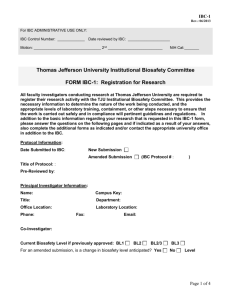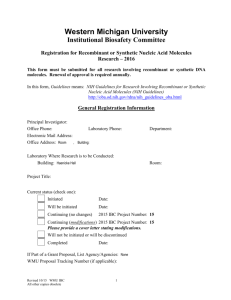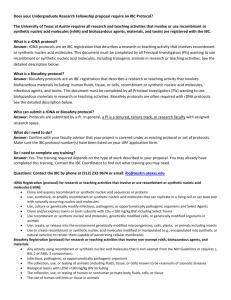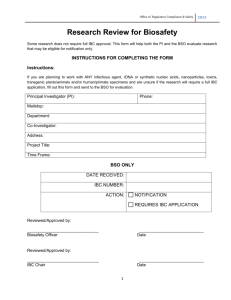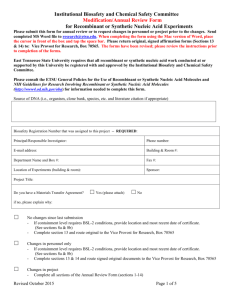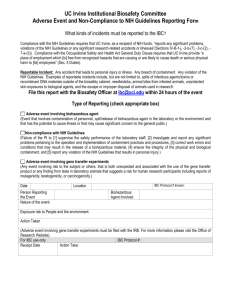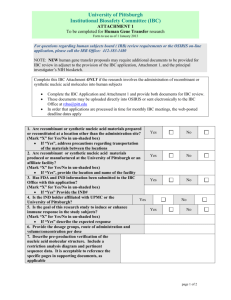IBC Research Application
advertisement
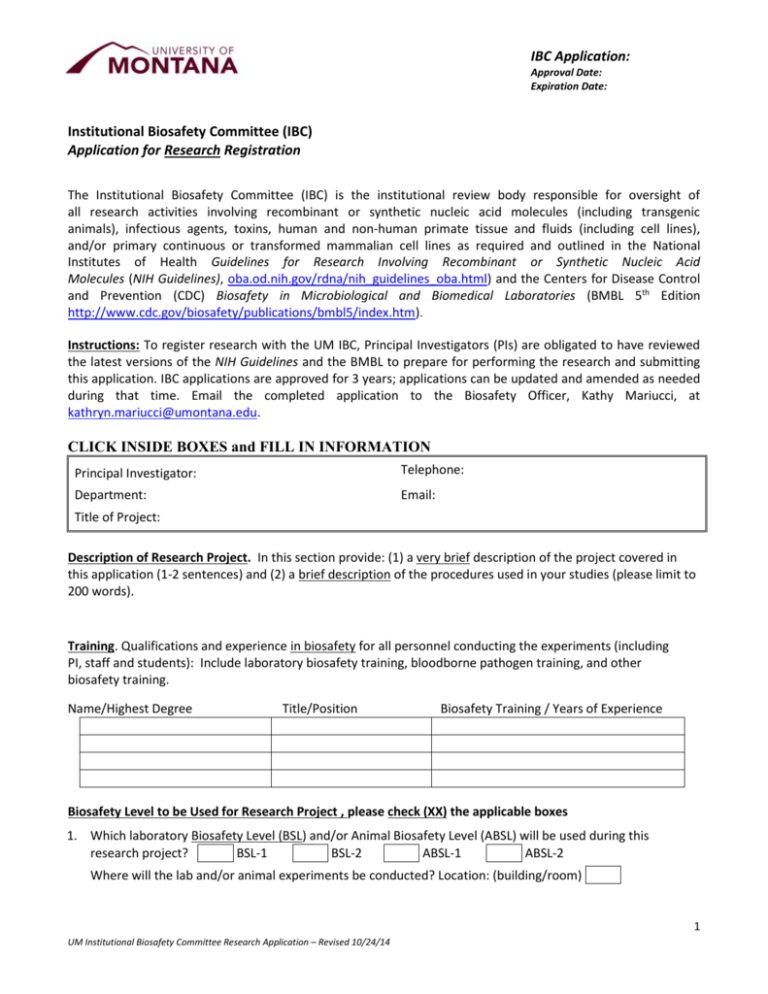
IBC Application: Approval Date: Expiration Date: Institutional Biosafety Committee (IBC) Application for Research Registration The Institutional Biosafety Committee (IBC) is the institutional review body responsible for oversight of all research activities involving recombinant or synthetic nucleic acid molecules (including transgenic animals), infectious agents, toxins, human and non-human primate tissue and fluids (including cell lines), and/or primary continuous or transformed mammalian cell lines as required and outlined in the National Institutes of Health Guidelines for Research Involving Recombinant or Synthetic Nucleic Acid Molecules (NIH Guidelines), oba.od.nih.gov/rdna/nih_guidelines_oba.html) and the Centers for Disease Control and Prevention (CDC) Biosafety in Microbiological and Biomedical Laboratories (BMBL 5th Edition http://www.cdc.gov/biosafety/publications/bmbl5/index.htm). Instructions: To register research with the UM IBC, Principal Investigators (PIs) are obligated to have reviewed the latest versions of the NIH Guidelines and the BMBL to prepare for performing the research and submitting this application. IBC applications are approved for 3 years; applications can be updated and amended as needed during that time. Email the completed application to the Biosafety Officer, Kathy Mariucci, at kathryn.mariucci@umontana.edu. CLICK INSIDE BOXES and FILL IN INFORMATION Principal Investigator: Telephone: Department: Email: Title of Project: Description of Research Project. In this section provide: (1) a very brief description of the project covered in this application (1-2 sentences) and (2) a brief description of the procedures used in your studies (please limit to 200 words). Training. Qualifications and experience in biosafety for all personnel conducting the experiments (including PI, staff and students): Include laboratory biosafety training, bloodborne pathogen training, and other biosafety training. Name/Highest Degree Title/Position Biosafety Training / Years of Experience Biosafety Level to be Used for Research Project , please check (XX) the applicable boxes 1. Which laboratory Biosafety Level (BSL) and/or Animal Biosafety Level (ABSL) will be used during this research project? BSL-1 BSL-2 ABSL-1 ABSL-2 Where will the lab and/or animal experiments be conducted? Location: (building/room) 1 UM Institutional Biosafety Committee Research Application – Revised 10/24/14 IBC Application: Approval Date: Expiration Date: 2. Which type of Biological Safety Cabinet (BSC) will be used? Other (explain) Class II Type A Class II Type B a. Where is the BSC located (building/room)? b. What is the make and model of the BSC? c. What is the date of the last annual certification of the BSC? Biohazard Component of Project [check (XX) the applicable boxes] YES NO Does this project use procedures that involve recombinant or synthetic nucleic acid molecules? (If yes, complete Part 1) YES NO Does this project involve the use of infectious agents (plant or animal pathogens, including bacterial, viral, fungal, protozoan agents; prions; or viral vectors)? (If yes, complete Part 2) YES NO Does this project involve the use of toxins of biological origin (naturally-occurring plant or animal toxins)? (If yes, complete Part 3) YES NO Does this project involve the use of human or non-human primate tissue or fluids (including blood, saliva, or excreta), or primary, continuous or transformed mammalian cell lines? (If yes, complete Part 4) The Principal Investigator agrees to comply with all requirements of The University of Montana IBC, the NIH Guidelines and the CDC BMBL, and further agrees to ensure that all members of the Principal Investigator’s laboratory are familiar with the risks of this project and have been trained in the use of appropriate techniques. Principal Investigator: Date: 2 UM Institutional Biosafety Committee Research Application – Revised 10/24/14 IBC Application: Approval Date: Expiration Date: Part 1 RESEARCH INVOLVING RECOMBINANT or SYNTHETIC NUCLEIC ACID MOLECULES 1. Recombinant or synthetic nucleic acid molecule experiments covered by the NIH Guidelines Check the appropriate registration category for experiments covered by NIH Guidelines (oba.od.nih.gov/rdna/nih_guidelines_oba.html). For a searchable database of risk groups go to http://www.absa.org/riskgroups/index.html. A. Experiments that Require IBC Approval, RAC Review, and NIH Director Approval Before Initiation (NIH Guidelines, Section III-A). Major Actions under the NIH Guidelines (select agents not available at UM) B. Experiments that Require NIH/OBA and IBC Approval Before Initiation (NIH Guidelines, Section III-B). Experiments involving the cloning of toxin molecules with LD50 of less than 100 nanograms per kilogram body weight (Section III-B-1) and experiments approved as Major Actions (not available at UM). C. Experiments that Require IBC and IRB Approvals and RAC Review Before Research Participant Enrollment (NIH Guidelines, Section III-C). Experiments involving the deliberate transfer of recombinant or synthetic DNA into one or more human research participants (human gene transfer; not available at UM). [Check (XX) the applicable boxes D-F] D. Experiments that Require IBC Approval Before Initiation (NIH Guidelines, Section III-D). Experiments using Risk Group 2, 3, 4 or restricted agents as host-vector systems (Section III-D-1). Experiments in which DNA from Risk Group 2, 3, 4 or restricted agents is cloned into nonpathogenic prokaryotic or lower eukaryotic host-vector systems (Section III-D-2). Experiments involving the use of infectious DNA or RNA viruses or defective DNA or RNA viruses in the presence of helper virus in tissue culture systems (Section III-D-3). Experiments involving whole animals (generating transgenic animals, and experiments involving viable recombinant or synthetic nucleic acid-modified microorganisms tested on whole animals; minimum BSL-2 required) (Section III-D-4). Experiments involving whole plants (to genetically engineer plants by recombinant or synthetic nucleic acid methods) (Section III-D-5). Experiments using more than 10 liters of culture (Section III-D-6). Experiments involving influenza viruses (Section III-D-7). E. Experiments that Require IBC Notice Simultaneous with Initiation (NIH Guidelines, Section III-E) Experiments involving the formation of recombinant or synthetic nucleic acid molecules containing no more than two-thirds of the genome of any eukaryotic virus (Section III-E-1). Experiments involving whole plants (using nucleic acid molecule-modified whole plants and/or experiments involving recombinant or synthetic nucleic acid molecule-modified organisms associated with whole plants) (Section III-E-2). 3 UM Institutional Biosafety Committee Research Application – Revised 10/24/14 IBC Application: Approval Date: Expiration Date: Experiments involving transgenic rodents (experiments involving the generation of transgenic rodents housed at BSL-1 only) (Section III-E-3). Other (Section III-E-3). Explain: F. Exempt Experiments (NIH Guidelines, Section III-F) Although the following recombinant or synthetic nucleic acid molecule experiments are EXEMPT from the NIH Guidelines (Section III-F), the UM IBC must approve all recombinant or synthetic nucleic acid research conducted at UM. Check [XX] the appropriate categories if your research falls under any of the following. Those that: (1) can neither replicate nor generate nucleic acids that can replicate in any living cell, and (2) are not designed to integrate into DNA, and (3) do not produce a toxin that is lethal for vertebrates (Section III-F-1). Those that are not in organisms, cells or viruses (Section III-F-2). Those that consist solely of the exact recombinant or synthetic nucleic acid sequence from a single source that exists contemporaneously in nature (Section III-F-3). Those that consist entirely of nucleic acids from a prokaryotic host including its indigenous plasmids or viruses when propagated only in that host (or a closely related strain of the same species), or when transferred to another host by well established physiological means (Section IIIF-4). Those that consist entirely of nucleic acids from a eukaryotic host including its chloroplasts, mitochondria, or plasmids (but excluding viruses) when propagated only in that host (or closely related strain of the same species) (Section III-F-5). Those that consist entirely of DNA segments from different species that exchange DNA by known physiological processes, though one or more of the segments may be a synthetic equivalent (Section III-F-6). Those genomic DNA molecules that have acquired a transposable element, provided the transposable element does not contain any recombinant and/or synthetic DNA (Section III-F-7). Those that do not present a significant risk to health or the environment, as determined by the NIH Director and following appropriate notice and opportunity for public comment (Section III-F-8). Recombinant or synthetic nucleic acid molecules in tissue culture (NIH Guidelines, Appendix C-I). For exceptions see Appendix C-I-A. Escherichia coli K12 host-vector systems (NIH Guidelines, Appendix C-II). For exceptions see Appendix C-II-A. Saccharomyces host-vector systems (NIH Guidelines, Appendix C-III). For exceptions see Appendix C-III-A. Kluyveromyces host-vector systems (NIH Guidelines, Appendix C-IV). For exceptions see Appendix C-IV-A. Bacillus subtilis or Bacillus licheniformis host-vector systems (NIH Guidelines, Appendix CV). For exceptions see Appendix C-V-A. Extrachromosomal elements of Gram positive organisms (NIH Guidelines, Appendix C-VI). For exceptions see Appendix C-VI-A. 4 UM Institutional Biosafety Committee Research Application – Revised 10/24/14 IBC Application: Approval Date: Expiration Date: The purchase or transfer of transgenic rodents at BSL-1 containment (NIH Guidelines, Appendix C-VII). Generation of BSL-1 transgenic rodents via breeding (NIH Guidelines, Appendix C-VIII). *** If ALL recombinant or synthetic nucleic acid research is EXEMPT, then skip the remainder of Part 1. 2. Description of recombinant or synthetic nucleic acid. A. What is the type of recombinant or synthetic nucleic acid (DNA, RNA, or other molecule that can base pair with naturally occurring nucleic acids; also note any chemical modification)? B. What is the host strain for propagation of recombinant or synthetic nucleic acid molecules? C. What is the source of the nucleic acid and what is the biological activity? D. YES NO Does the recombinant or synthetic nucleic acid contain genes for the biosynthesis of toxic molecules lethal for vertebrates? If yes, provide the LD50 information. 3. Recombinant or synthetic nucleic acid research project involves (check XX all that apply) Animals (indicate species): Cell culture (species of origin): Explanted tissue (species of origin): Bacteria (indicate species): Fungi (indicate species): Viruses (indicate species): Other: A. If working with recombinant or synthetic nucleic acids of microorganisms, identify the risk group (www.absa.org/riskgroups/index.html) or refer to the NIH Guidelines, Appendix B, oba.od.nih.gov/rdna/nih_guidelines_oba.html. Risk group: B. If working with recombinant or synthetic nucleic acids in animals, answer the following: (1) List the invertebrate species to be used (2) List the vertebrate species to be used Approved IACUC animal use protocol (AUP) number 4. Safety procedures for handling recombinant or synthetic nucleic acid (BSL-1, BSL-2, and/or ABSL-2) Describe safety procedures that will be employed to minimize risk of exposure and prevent release of recombinant or synthetic nucleic acid (for example, lab coats, gloves, face shields, biological safety cabinets, spill mats, sharps disposal procedures, waste disposal procedures, decontamination and waste handling, and transporting the recombinant or synthetic nucleic acid). Please be complete and concise. 5 UM Institutional Biosafety Committee Research Application – Revised 10/24/14 IBC Application: Approval Date: Expiration Date: Part 2 INFECTIOUS AGENTS 1. Infectious agents A. List infectious agent(s) to be used in this research project Which Biosafety Level (BSL) is required? BSL-1 BSL-2 What are the known hosts for this agent? B. List viral vectors (AAV, lentivirus, baculovirus, etc.) to be used in this research project Which Biosafety Level (BSL) is required? BSL-1 What are the known hosts for the viral vector? BSL-2 2. Training and other requirements [check XX all boxes that apply] A. YES NO Have all personnel involved with these experiments received initial training and annual updates regarding the handling of this infectious agent? Documentation of training must be maintained and updated annually by the PI. B. YES NO Is there a vaccine available and recommended for persons working with this agent? YES NO If a vaccine is available, but a researcher declines vaccination, has a declination of vaccination been filed with the PI? Documentation of vaccination or declination for all personnel must be maintained by the PI. 3. Infection of animals [check XX all boxes that apply] A. Does the project involve the infection of animals? (1). List the invertebrate species to be infected (2). List the vertebrate species to be infected YES NO a. List the approved IACUC Animal Use Protocol (APU) for this agent b. At which Animal Biosafety Level (ABSL) will animals be housed? ABSL-1 ABSL-2 B. Provide an SOP for containing the infectious animals (see 4C below). 4. Safety procedures for handling infectious agents in the laboratory and/or animal facility A. Describe safety procedures that will be employed to minimize risk of exposure and prevent release of infectious agents (for example, lab coats, gloves, face shields, biological safety cabinets, spill mats, sharps disposal procedures, waste disposal procedures, decontamination and waste handling, and transporting the infectious agent). Please be complete and concise. B. Accidental spill or exposure. Describe the protocol that will be employed, decontamination agents, equipment to be used (for example, autoclave, biohazard bag, disinfectants, etc.), where to file work6 UM Institutional Biosafety Committee Research Application – Revised 10/24/14 IBC Application: Approval Date: Expiration Date: related accident reports, and where to seek medical help including the best course of action to be taken by health care providers in the event of human exposure, including treatment options and references. Supply enough detail for a physician to initiate treatment after checking reference(s). Note that the course of action must include: 1) washing the affected skin thoroughly with soap and water or flooding mucous membranes with water for 15 minutes, 2) seeking medical attention at Curry Health Center or with another physician, if warranted, and 3) filing a ‘First Report of Injury’ with Environmental Health and Risk Management, 243-2842, within 24 hours. Please be complete and concise. C. Attach any specific protocols and SOPs developed for this study. 7 UM Institutional Biosafety Committee Research Application – Revised 10/24/14 IBC Application: Approval Date: Expiration Date: Part 3 TOXINS OF BIOLOGICAL ORIGIN 1. Work with toxins of biological origin A. What toxin (unfractionated mixture, purified conjugate, or microbial culture capable of producing toxin) will be used with the experiment? B. What is the LD50 of the toxin? C. Where will the toxin be produced and/or stored? (Building Room) D. What is the maximum amount of toxin produced in any single experiment or purchased in any single order? E. What is the maximum amount of toxin that will be stored in the lab at any given time? F. If the toxin is to be weighed, where will the weighing be done? (Building Room) G. Where will the experiments be conducted? (Building Room) H. Does the experiment involve the administration of toxin to animals? I. YES NO List animal species to be used: For vertebrate animals, list AUP # At which Animal Biosafety Level (ABSL) will animals be housed? Describe the necessary safety considerations to protect staff during animal housing. Describe how toxin-containing materials (urine, blood, feces, bedding, etc.) will be inactivated. YES NO ABSL-1 ABSL-2 Have all personnel involved with this project received initial training and annual updates regarding the procedures for handling this toxin? Documentation of training must be maintained and updated annually by the PI. J. YES NO Is there an antidote available for persons exposed to the toxin? K. If the toxin has been modified to make it safer to use, provide the information and describe the modification. 2. Safety procedures for handling toxins in the laboratory and/or animal facility A. Describe safety procedures that will be employed to minimize risk of exposure and prevent release of toxins (for example, lab coats, gloves, face shields, biological safety cabinets, spill mats, sharps disposal procedures, waste disposal procedures, decontamination and waste handling, and transporting the toxin). Please be complete and concise. B. Accidental spill or exposure. Describe the protocol that will be employed, decontamination agents, equipment to be used (for example, autoclave, biohazard bag, disinfectants, etc.), where to file work8 UM Institutional Biosafety Committee Research Application – Revised 10/24/14 IBC Application: Approval Date: Expiration Date: related accident reports, and where to seek medical help including the best course of action to be taken by health care providers in the event of human exposure, including treatment options and references. Supply enough detail for a physician to initiate treatment after checking reference(s). Note that the course of action must include: 1) washing the affected skin thoroughly with soap and water or flooding mucous membranes with water for 15 minutes, 2) seeking medical attention at Curry Health Center or with another physician, if warranted, and 3) filing a ‘First Report of Injury’ with Environmental Health and Risk Management, 243-2842 within 24 hours. Please be complete and concise. C. Attach any specific protocols and SOPs developed for this study. 9 UM Institutional Biosafety Committee Research Application – Revised 10/24/14 IBC Application: Approval Date: Expiration Date: Part 4 HUMAN or NON-HUMAN PRIMATE BLOOD, BODY FLUIDS, TISSUES, or PRIMARY, CONTINUOUS OR TRANSFORMED MAMMALIAN CELL LINES 1. Experiments using human or non-human primate (check XX all that may apply): Blood Body fluids Tissues Primary culture or explant (includes organ culture and dispersed cell cultures with a limited passage life) Cell strains (normal cell lines; non-immortal cells adapted to grow on plastic; restricted number of passages before senescence; often diploid) Cell lines (continuous or permanent cell cultures; immortal; transformed by addition of SV40, EBV, E1a, hTert expressing vector or can occasionally be spontaneously transformed; typically aneuploid) 2. Indicate origin of blood/body fluid/tissue: Human. Describe briefly: IRB approval number if applicable: Non-human primate. Describe briefly: 3. YES NO If the blood, body fluid or tissue is obtained from humans, will these materials be obtained from people known to be infected with agents from Risk Group 3 or higher (for example, hepatitis B, HIV)? If ‘yes’, from people infected with (list agents): 4. List the human and non-human primate cell lines used in this research: 5. List all other mammalian cell lines used in this research: 6. Exposure Control Plan for human bloodborne pathogens (a) YES (s) YES (a) YES NO Do you use the online UM Bloodborne Pathogens Exposure Control Plan? http://umt.edu/research/compliance/IBC/bbp.php NO Do you have your own specific bloodborne pathogens exposure control plan in place? If ‘yes’, briefly describe. 7. Bloodborne pathogens training NO Have you and the members of your lab completed annual Bloodborne Pathogens (BBP) Training? (b) The online training and quiz are accessible at http://umt.edu/research/compliance/IBC/bbp.php (c) Everyone working with human blood, tissue or cell lines must complete annual UM BBP training. (d) Documentation of BBP training must be maintained by the PI and updated annually for all personnel. 10 UM Institutional Biosafety Committee Research Application – Revised 10/24/14 IBC Application: Approval Date: Expiration Date: 8. Hepatitis B Virus vaccination , http://umt.edu/research/compliance/IBC/forms.php (a) YES NO Have all staff and students working with human blood, tissue or cell lines been vaccinated for HBV? (b) YES NO Documentation of seroconversion is recommended. Has seroconversion been documented for all those vaccinated? (c) YES NO If a researcher declines vaccination, has a declination of vaccination been filed with the PI? Documentation of vaccination or declination for all personnel must be maintained by the PI. 9. Safety procedures for handling human and non-human primate blood, fluids, and tissues and for handling primary, continuous or transformed mammalian cell lines. A. Describe safety procedures that will be employed to minimize risk of exposure and prevent release of infectious agents (for example, lab coats, gloves, face shields, biological safety cabinets, spill mats, sharps disposal procedures, waste disposal procedures, decontamination, waste handling, and transportation of human blood products). Please be complete and concise. B. Accidental spill or exposure. Describe the protocol that will be employed, decontamination agents, equipment to be used (for example, autoclave, biohazard bag, disinfectants, etc.), where to file workrelated accident reports, and where to seek medical help including the best course of action to be taken by health care providers in the event of human exposure, including treatment options and references. Supply enough detail for a physician to initiate treatment after checking reference(s). Note that the course of action must include: 1) washing the affected skin thoroughly with soap and water or flooding mucous membranes with water for 15 minutes, 2) seeking medical attention at Curry Health Center or with another physician, if warranted, and 3) filing a ‘First Report of Injury’ with Environmental Health and Risk Management, 243-2842. Please be complete and concise. C. Attach any specific protocols and SOPs developed for this study. 11 UM Institutional Biosafety Committee Research Application – Revised 10/24/14

